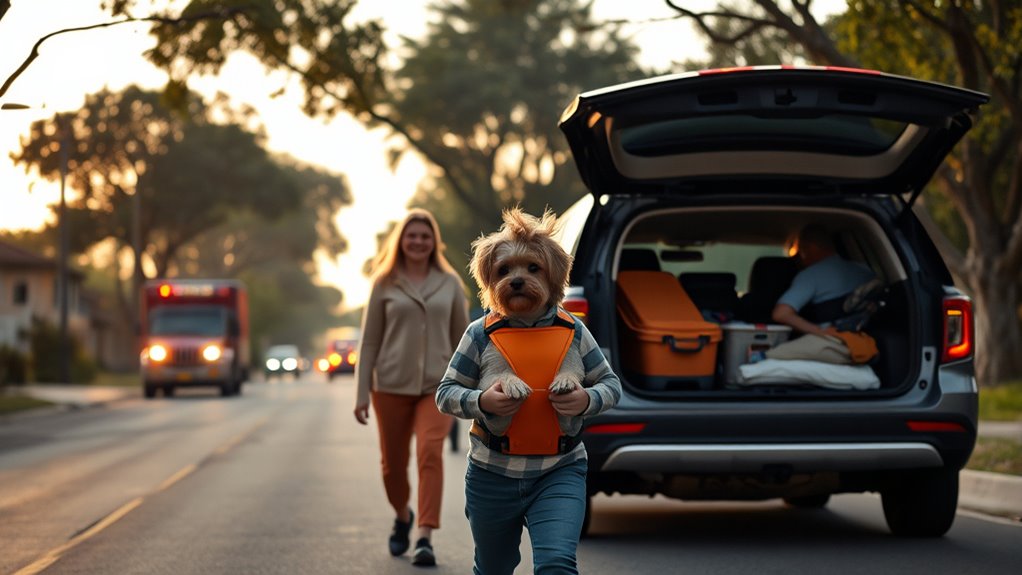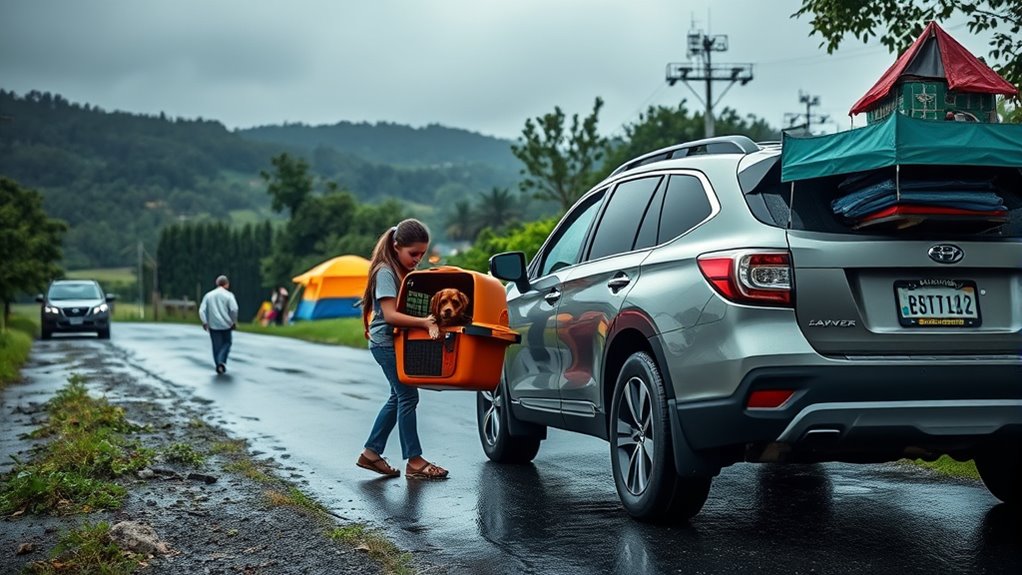When evacuating with pets, plan your routes carefully by identifying nearby pet-friendly shelters and avoiding traffic or blocked roads. Keep printed maps or GPS directions handy, and know multiple escape routes in case of emergencies. Pack an emergency kit with essentials your pet needs, including food, water, and medication. Attach current ID tags and have recent photos ready. Staying prepared with these strategies will help you keep your pets safe during a crisis; learn more to be fully ready.
Key Takeaways
- Identify pet-friendly shelters and safe zones along planned evacuation routes in advance.
- Map out multiple routes avoiding traffic and blocked roads, keeping GPS directions or printed maps accessible.
- Pack an emergency kit with food, water, medications, leashes, carriers, and comfort items for your pet.
- Consider your pet’s specific needs, including mobility and medical requirements, and prepare backup travel plans.
- Share your evacuation plan with family or friends and keep identification tags updated for quick recovery.

When emergencies strike, evacuating quickly is essential, and doing so with pets requires careful planning. You can’t afford to leave pet safety to chance when every second counts. Preparing in advance ensures you can move swiftly and keep your furry friends safe. One of the first steps is to determine the best routes to emergency shelters and safe zones. Familiarize yourself with multiple evacuation routes from your home, workplace, and other frequented locations. Keep printed maps or saved GPS directions handy, especially ones that show pet-friendly shelters. Knowing your options reduces confusion during chaos and helps you avoid traffic or blocked roads. It’s also wise to identify shelters that accept pets, as many emergency facilities may not allow animals. Contact local authorities or visit official websites ahead of time to compile a list of pet-friendly shelters and accommodations nearby. This way, you won’t waste time searching when urgency is high.
Having emergency supplies prepared is critical for a smooth evacuation. Your pet’s safety hinges on having everything they need at your fingertips. Pack a well-stocked emergency kit that includes essentials like food, water, medications, and any special items your pet requires, such as leashes, harnesses, or carriers. Don’t forget about comfort items like their favorite toy or blanket, which can help reduce stress during stressful times. Keep this kit in an accessible, portable bag so you can grab it quickly if you need to evacuate suddenly. Regularly check and refresh supplies to guarantee everything remains usable and stocked. Remember, your pet’s safety depends on your preparedness, so double-check that your emergency supplies are complete and ready to go at a moment’s notice. Incorporating small appliance safety tips can also ensure that your home remains secure during emergency situations, preventing additional hazards.
When planning your routes and shelter options, consider your pet’s unique needs. For example, if your pet has mobility issues or special medical requirements, make sure your route avoids obstacles and includes access to veterinary care if needed. Keep a recent photo of your pet in case they get lost during evacuation. Attach identification tags with your current contact information and keep a backup plan for long-distance travel if necessary. Communicate your plans with family or friends who can assist or take in your pets if you’re separated. By proactively planning routes, shelters, and emergency supplies, you’re setting yourself up for a safer evacuation. Your goal is to act swiftly while guaranteeing your pet’s safety and comfort, minimizing stress for both of you during emergencies.
Frequently Asked Questions
How Do I Find Pet-Friendly Shelters During an Emergency?
To find pet-friendly shelters during an emergency, you should research local resources ahead of time. Use online tools like the American Red Cross or local government websites to locate pet-friendly shelter options. Keep a list of these shelters, along with their contact info, in your emergency kit. This way, you’re prepared for emergency planning, ensuring you can quickly find shelter that welcomes your pets when you need it most.
What Emergency Supplies Should I Prepare Specifically for My Pet?
Your pet’s safety depends on your prep. Pack a pet first aid kit, emergency nutrition like non-perishable food, and extra water. Include familiar items such as their favorite toy and blanket to comfort them. Don’t forget any medications they need. These supplies are like a lifeline, ensuring your furry friend stays safe, healthy, and calm during chaos. Be ready, because their well-being is worth more than anything.
How Can I Keep My Pet Calm During Evacuation?
To keep your pet calm during evacuation, use calming techniques like gentle petting and speaking softly. Bring soothing items such as their favorite blanket or toy to provide comfort. Maintain a calm demeanor yourself, as animals pick up on your emotions. Create a familiar environment in their carrier or crate, and keep a consistent routine as much as possible. These steps help reduce your pet’s anxiety and make the process smoother.
What Should I Do if My Pet Gets Lost During Evacuation?
Think of losing your pet during evacuation like a needle in a haystack. Act quickly by using pet identification methods such as collars, microchips, or photos. Contact local shelters and animal control for lost pet recovery. Spread the word with flyers and social media. Your prompt action improves chances of finding your pet, ensuring they’re safely back in your arms rather than lost in the chaos.
Are There Specific Routes Safer for Pets During Different Emergencies?
You should always check evacuation maps for designated pet safety routes, as these are tailored to protect your furry friend during emergencies. Some routes may be safer than others, especially in floods or fires. Use these pet-specific routes whenever possible, and plan ahead by familiarizing yourself with alternative paths. This way, you guarantee your pet’s safety and avoid delays, making the evacuation smoother for both of you.
Conclusion
Remember, your pets depend on your planning just as much as you rely on your instincts. By mapping out routes and shelters beforehand, you’re weaving a safety net that catches them in times of chaos. Think of your preparations as a lighthouse guiding your loved ones through stormy seas—constant, unwavering, and essential. When you prioritize their safety, you illuminate a path that turns uncertainty into confidence, ensuring everyone reaches safety together.










